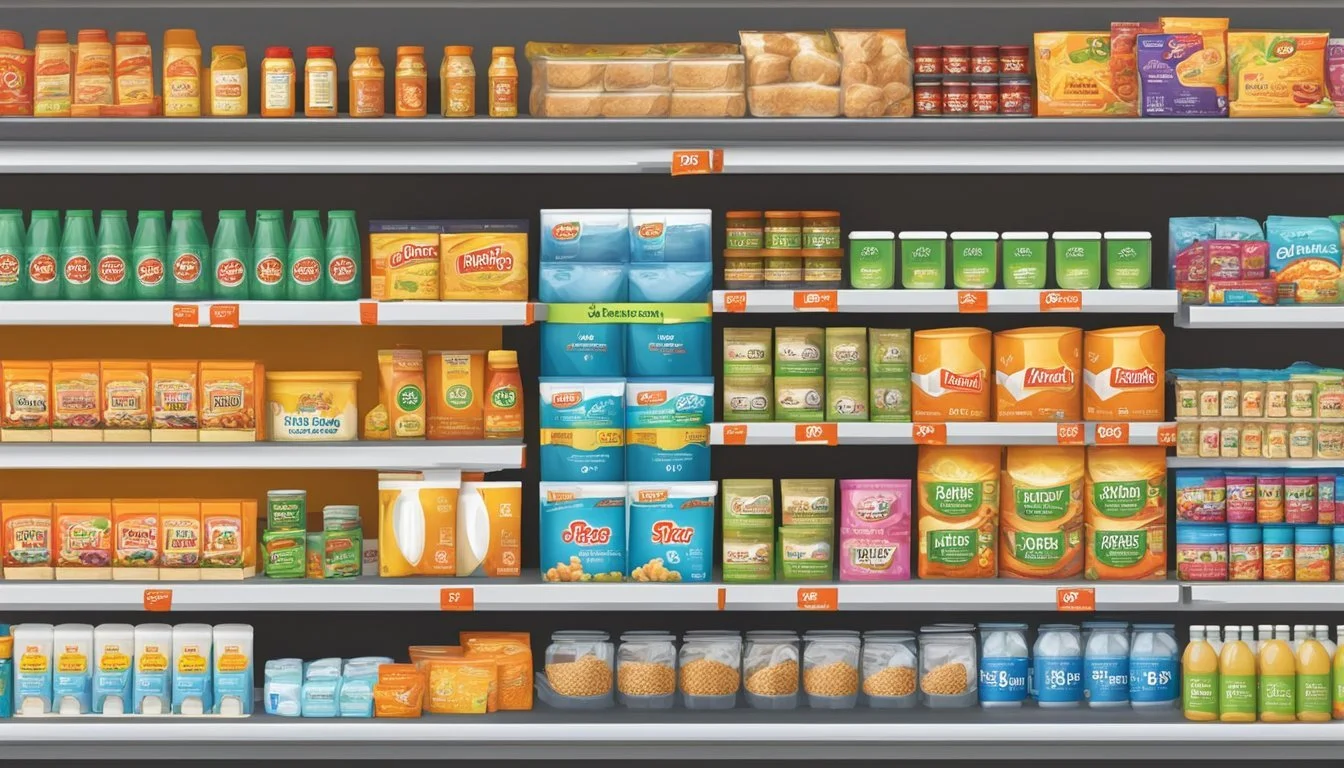Is Family Dollar Cheaper Than Hannaford?
A Price Comparison of Budget Retailers
When it comes to grocery shopping, finding the best deals can make a significant difference in your household budget. Many shoppers wonder whether Family Dollar or Hannaford offers better prices for their everyday needs. While both stores cater to budget-conscious consumers, they have different focuses and pricing strategies.
Hannaford typically offers lower prices on groceries compared to Family Dollar. Hannaford is a full-service supermarket chain that provides a wide range of fresh produce, meats, and household essentials. Family Dollar, on the other hand, is a discount variety store that carries a limited selection of groceries alongside other merchandise.
A price comparison between these two retailers reveals that Hannaford's grocery prices are generally more competitive. This is partly due to Hannaford's larger scale and focus on groceries, which allows them to negotiate better deals with suppliers. Family Dollar may offer competitive prices on certain items, but for a full grocery shopping trip, Hannaford is likely to provide better overall value.
Understanding the Retail Landscape
The grocery retail landscape in the United States features a diverse array of chains catering to different consumer needs and preferences. Family Dollar and Hannaford represent distinct segments within this competitive market.
Diverse Grocery Chains
Walmart, Target, and Amazon dominate the retail space with their vast networks and diverse product offerings. Traditional supermarkets like Stop & Shop and Wegmans maintain strong regional presences. Discount chains such as Aldi and Dollar General focus on budget-conscious shoppers.
Specialty retailers like Whole Foods cater to health-conscious consumers. Online grocery services have gained traction, with many chains offering delivery and pickup options.
Market Basket stands out for its competitive pricing and loyal customer base in the Northeast.
Family Dollar's Business Model
Family Dollar operates as a discount variety store chain. It primarily targets low to middle-income shoppers in urban and rural areas.
The chain offers a mix of grocery items, household goods, and basic apparel at budget-friendly prices. Family Dollar stores are typically smaller than traditional supermarkets, allowing for convenient neighborhood locations.
In recent years, Family Dollar has faced challenges. The company has undergone store closures and rebranding efforts to improve profitability.
Hannaford's Market Position
Hannaford is a regional supermarket chain with a strong presence in the Northeast United States. It competes directly with other full-service grocery stores.
The chain emphasizes fresh produce, quality store brands, and competitive pricing. Hannaford stores tend to be larger than discount retailers, offering a wider selection of products.
Hannaford has invested in digital initiatives, including online ordering and curbside pickup services. The company has also focused on sustainability efforts and community engagement to differentiate itself in the market.
Price Structures in Retail
Retail pricing involves various strategies to attract customers and maximize profits. Stores use different approaches to set prices, balancing affordability with profitability.
Pricing Strategies
Retailers employ several pricing tactics to remain competitive. Everyday low pricing (EDLP) aims to offer consistently low prices across all products. High-low pricing alternates between regular prices and periodic discounts. Loss leader pricing sets certain items below cost to draw customers in.
Some stores use psychological pricing, ending prices with .99 to make them appear lower. Bundle pricing groups related items at a discount. Dynamic pricing adjusts prices based on demand, time, or customer data.
Store Brand vs. Name Brand
Store brands, also known as private labels, typically offer lower prices than national brands. These products are often 15-30% cheaper due to reduced marketing costs and streamlined production.
Many retailers develop their own brands to increase profit margins and provide budget-friendly alternatives. Store brands have improved in quality over time, often matching or surpassing name brands in taste tests and consumer ratings.
Name brands still command higher prices due to brand recognition and marketing efforts. However, the price gap between store and name brands has narrowed in recent years.
Discount Retailing
Discount retailers focus on offering products at lower prices than traditional stores. They achieve this through various methods:
Bulk purchasing to negotiate better deals with suppliers
Simplified store designs and fewer amenities to reduce overhead costs
Limited product selection to increase efficiency
Faster inventory turnover to minimize storage costs
Dollar stores and off-price retailers often sell closeout or overstock items at steep discounts. Some discount chains offer membership programs for additional savings.
These stores prioritize low prices over brand selection or shopping experience. However, many have improved their product quality and store aesthetics to attract a broader customer base.
Product Categories and Pricing
Family Dollar and Hannaford offer different product selections and pricing strategies across various grocery categories. Their approaches to pricing and product availability can impact overall shopping costs for consumers.
Fresh Produce
Family Dollar's produce selection is typically limited compared to Hannaford. They may offer some basic fruits and vegetables like tomatoes, potatoes, and carrots, often at competitive prices. However, the quality and freshness can be inconsistent.
Hannaford provides a wider variety of fresh produce, including organic options. Their fruits and vegetables are generally of higher quality but may be priced slightly higher than Family Dollar's offerings. Hannaford often runs sales on seasonal produce, which can bring prices down to competitive levels.
Meat and Dairy
Family Dollar's meat selection is mostly limited to frozen and processed options. They offer some dairy products like milk and cheese at low prices, but the variety is restricted.
Hannaford has a full-service meat department with fresh cuts, ground meats, and poultry. Their chicken breasts and other popular items are competitively priced. Hannaford's dairy section is extensive, featuring a range of milk, cheese, yogurt, and specialty products. While prices may be higher than Family Dollar for some items, the quality and selection are superior.
Dry Goods and Pantry Items
Family Dollar excels in this category, offering a wide range of shelf-stable items at consistently low prices. Their selection includes:
Canned goods
Pasta and rice
Snacks and cookies
Condiments
Hannaford's dry goods section is more extensive, with a mix of national brands and private label options. Their prices on these items are generally higher than Family Dollar, but they offer more variety and higher-quality alternatives.
Frozen Foods
Family Dollar stocks a basic selection of frozen foods, focusing on budget-friendly options like:
Frozen pizzas
TV dinners
Ice cream
Frozen vegetables
Hannaford's frozen food section is more comprehensive, including premium brands and healthier options. While some items may be pricier than Family Dollar, Hannaford often runs promotions on frozen foods, making them more competitive.
Cost Analysis
Family Dollar and Hannaford offer different shopping experiences and price points. A careful examination of their pricing strategies reveals key differences that impact overall affordability for consumers.
Comparing Everyday Items
Family Dollar typically offers lower prices on many common household items compared to Hannaford. Cleaning supplies, toiletries, and pantry staples are often cheaper at Family Dollar.
A grocery list for a family of 4 might include:
Bread: $1.50 at Family Dollar vs $2.29 at Hannaford
Milk (1 gallon): $3.25 vs $3.79
Eggs (1 dozen): $2.50 vs $2.99
Pasta (1 lb): $1.00 vs $1.49
However, Hannaford generally provides better quality and variety in fresh produce and meats. While prices may be higher, the selection is often superior.
Bulk Purchasing Impact
Hannaford tends to offer more bulk purchasing options, which can lead to savings for larger families or those who prefer to stock up. Family Dollar's limited space restricts bulk offerings.
Bulk savings examples at Hannaford:
5 lb bag of rice: $4.99 ($1.00/lb)
10 lb bag of potatoes: $3.99 ($0.40/lb)
3 lb bag of apples: $3.99 ($1.33/lb)
Family Dollar often sells smaller package sizes, which may have a higher per-unit cost but lower upfront price. This can be beneficial for budget-conscious shoppers who need to stretch their dollars.
Seasonal Price Variations
Both stores adjust prices based on seasonal factors, but their approaches differ. Family Dollar tends to have consistent pricing year-round with occasional sales. Hannaford typically offers deeper discounts during peak seasons.
Summer produce prices at Hannaford:
Watermelon: $3.99 each
Corn: $0.50 per ear
Tomatoes: $1.99/lb
Family Dollar's seasonal offerings are more limited but may include discounted summer essentials like sunscreen or beach toys. Their holiday-themed items are often priced competitively, making them a good option for seasonal decor and gifts.
Consumer Experience
Family Dollar and Hannaford offer distinct shopping experiences that influence customer satisfaction and loyalty. The atmosphere, store layout, and rewards programs shape how consumers perceive and interact with each retailer.
Shopping Ambiance and Service
Family Dollar stores typically have a no-frills environment focused on value. The aisles are often cramped, with merchandise stacked high. Lighting can be harsh, and the overall atmosphere is utilitarian.
Service at Family Dollar is generally minimal. Customers usually need to seek out assistance if required. Checkout lines can be long during busy periods due to limited staff.
Hannaford, in contrast, aims for a more pleasant shopping experience. Stores are well-lit and spacious, with wider aisles. The ambiance is more inviting, with an emphasis on fresh produce and quality products.
Hannaford typically provides better customer service. Staff are more readily available to assist shoppers. Checkout lines tend to move faster, enhancing the overall experience.
Store Layout and Accessibility
Family Dollar stores are compact, making navigation challenging at times. Products are densely packed, which can make finding specific items difficult. The layout prioritizes efficiency over browsing comfort.
Accessibility can be an issue in some Family Dollar locations. Narrow aisles may pose challenges for customers with mobility aids or strollers.
Hannaford stores feature a more intuitive layout. Departments are clearly marked, and products are logically arranged. The spacious design allows for easier movement throughout the store.
Hannaford emphasizes accessibility. Wide aisles accommodate various needs, and stores often include features like motorized carts for customers with limited mobility.
Consumer Loyalty Programs
Family Dollar's loyalty program is straightforward. Customers can sign up for a Smart Coupons account to access digital coupons and exclusive discounts. The program is basic but can provide savings for frequent shoppers.
Hannaford offers a more comprehensive loyalty program called My Hannaford Rewards. Members earn points on purchases, which can be redeemed for grocery discounts. The program also provides personalized coupons and special offers.
Hannaford's program tends to foster stronger customer loyalty. It offers more tangible benefits and a sense of value beyond immediate discounts. This approach helps build a more committed customer base.
Both programs are free to join, but Hannaford's rewards system is generally viewed as more robust and beneficial to regular customers.
Meal Planning and Budgeting
Effective meal planning and budgeting can significantly reduce grocery costs while ensuring nutritious meals for families. Strategic approaches help maximize savings at both Family Dollar and Hannaford.
Creating a Cost-Effective Grocery List
Start by inventorying current pantry items to avoid duplicate purchases. Plan meals around sales and seasonal produce to capitalize on lower prices. Include versatile ingredients that can be used in multiple dishes throughout the week.
Create a detailed list organized by store sections to streamline shopping. Focus on whole foods and ingredients rather than pre-made meals, which often cost more. Consider generic or store-brand alternatives to name-brand products for additional savings.
Prioritize items that offer the most value for money, such as:
Bulk grains (rice, oats, pasta)
Frozen vegetables
Canned beans and tomatoes
Eggs
In-season fruits and vegetables
Understanding Cost Per Meal
Calculate the cost per serving for each planned meal to better manage the food budget. This approach helps identify which meals provide the most value and where adjustments can be made.
Example cost breakdown for a family dinner:
Chicken breasts: $6.00 (4 servings)
Brown rice: $0.50 (4 servings)
Frozen broccoli: $1.50 (4 servings)
Total cost: $8.00
Cost per serving: $2.00
Track these costs over time to identify trends and opportunities for further savings. Consider batch cooking larger portions of cost-effective meals for leftovers or freezing, reducing the overall cost per serving.
Saving Strategies for Families
Implement a "meatless Monday" or similar concept to reduce spending on typically expensive protein sources. Utilize cheaper protein alternatives like beans, lentils, or eggs in these meals.
Plan for strategic use of leftovers to minimize food waste. For example, use leftover roast chicken in sandwiches or salads for lunch the next day.
Encourage family involvement in meal planning and preparation. This can lead to better acceptance of budget-friendly meals and teach valuable skills. Consider growing herbs or easy vegetables at home to supplement store-bought produce.
Use apps or websites to compare prices between Family Dollar and Hannaford, ensuring the best deals on each item. Take advantage of loyalty programs, digital coupons, and cash-back offers to maximize savings at both stores.
Comparative Shopping
Comparing prices between stores requires a strategic approach. Local variations, online tools, and regional comparisons can help shoppers find the best deals.
Local Price Variation
Prices at Family Dollar and Hannaford can vary significantly between locations. In New Hampshire, Family Dollar often offers lower prices on household items and non-perishables. Hannaford tends to have more competitive prices on fresh produce and meats.
Store locations impact pricing. Urban Family Dollar stores may have higher prices than rural ones due to increased operating costs. Hannaford's pricing is generally more consistent across locations.
Weekly sales and promotions affect comparative shopping. Family Dollar frequently runs dollar deals, while Hannaford offers loyalty card discounts. Shoppers should check weekly circulars for both stores to maximize savings.
Online Price Checking
Digital tools simplify price comparisons. Many shoppers use apps to compare Family Dollar and Hannaford prices with other retailers like Walmart and Price Chopper.
Hannaford's website allows customers to view current prices and create shopping lists. Family Dollar's site showcases weekly ads but doesn't provide real-time pricing.
Third-party apps aggregate prices from multiple stores. These tools help shoppers identify the cheapest options for specific items across different retailers.
Some apps offer price history features. This function allows users to track price fluctuations at Family Dollar, Hannaford, and competitors over time.
Regional Supermarket Comparisons
In the Northeast, Hannaford competes with regional chains like Price Chopper and Giant. Family Dollar faces competition from other discount stores and larger retailers like Walmart.
A study comparing 32 common items found Hannaford to be 19% cheaper than Price Chopper. This significant difference can lead to substantial savings over time.
Walmart often beats both Family Dollar and Hannaford on price for many items. However, Hannaford frequently offers better quality produce and meats.
Regional factors influence pricing strategies. In areas with more competition, Family Dollar and Hannaford may adjust prices to stay competitive with local chains and discount stores.
Consumer Education
Empowering shoppers with knowledge is crucial for making informed decisions between retailers like Family Dollar and Hannaford. Key aspects include understanding pricing strategies, recognizing marketing tactics, and utilizing available resources.
Understanding Unit Pricing
Unit pricing helps consumers compare product costs across different sizes and brands. It displays the price per unit of measurement, such as per ounce or pound. This tool is especially useful when comparing Family Dollar and Hannaford offerings.
Retailers like Price Rite often use unit pricing prominently, making it easier for budget-conscious shoppers to find the best deals. Hannaford typically provides clear unit pricing on shelf labels.
To use unit pricing effectively, shoppers should:
Look for the unit price on shelf labels
Compare unit prices rather than total prices
Be aware that larger packages don't always offer the best value
The Impact of Marketing
Marketing strategies significantly influence consumer choices between stores like Family Dollar and Hannaford. Recognizing these tactics helps shoppers make more objective decisions.
Trader Joe's, known for its loyal following, demonstrates effective marketing through unique product offerings and friendly customer service. This approach creates an emotional connection with customers.
Key marketing elements to consider:
Store layout and product placement
Sales promotions and discounts
Brand positioning and reputation
Hannaford often emphasizes its high-quality produce and prepared foods to attract health-conscious consumers. Family Dollar, on the other hand, focuses on value and convenience in its marketing.
Consumer Resources
Several tools and resources help area consumers make informed choices between Family Dollar, Hannaford, and other retailers. The Consumerpedia Podcast offers in-depth analyses of various consumer topics, including grocery shopping strategies.
Online comparison tools allow shoppers to check prices across multiple stores before making purchases. Many retailers also offer mobile apps with digital coupons and personalized deals.
Useful consumer resources include:
Local consumer protection agencies
Online price comparison websites
Store loyalty programs and apps
Consumer advocacy groups
These resources empower shoppers to maximize savings and make informed decisions when choosing between Family Dollar, Hannaford, and other grocery options.










